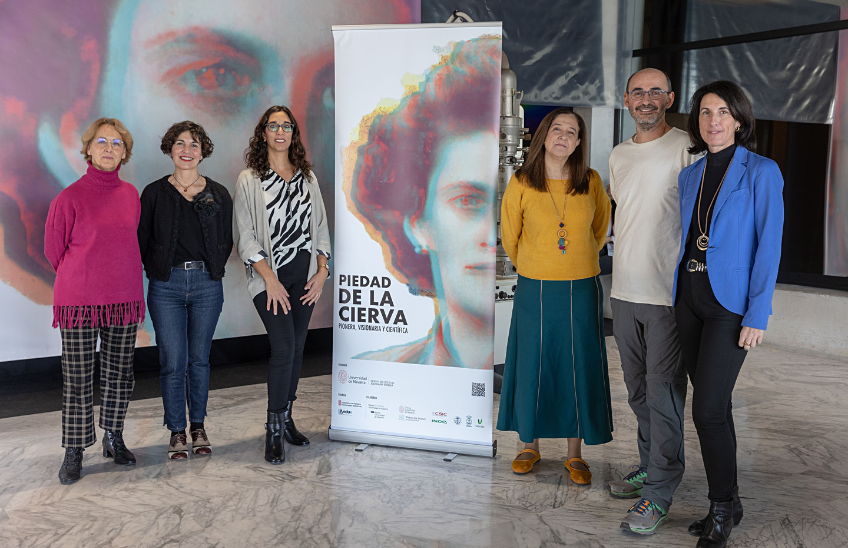Inmaculada Alva: "Piedad De la Cierva is a reference for many young women who want to dedicate themselves to science".
The roundtable "Mujeres que inspiran" (Women who inspire) opens at the University of Navarra a exhibition on this scientist, pioneer in the Spanish research

FotoManuelCastells/From left to right, Ana Rouzaut, Gurutze Pérez, Eliana Fucili, Inmaculada Alva, Sergio Barbero and María Sandúa.
21 | 11 | 2024
"Piedad De la Cierva's greatest contribution was herself, because she is a reference for many young women who want to dedicate themselves to science". With these words, Inmaculada Alva, researcher at the Center of programs of study Josemaría Escrivá (CEJE) of the University of Navarra, opened the roundtable "Women who inspire", the inaugural event of the exhibition Piedad de la Cierva: Pioneer, visionary and scientist.
The sample, which will remain open at the Main Library of the University of Navarra until March 14, 2025, pays tribute to this scientist from Murcia (1913-2007), a pioneer in Spanish research . Organized by the Center programs of study Josemaría Escrivá, in partnership with the Science Museum, the Museum of the University and the group Women for Science, offers an overview of her career and contributions in fields where she broke scientific barriers, such as X, optical glass and refractory bricks. It also recreates the research environment in which she worked with original materials and objects from the mid-twentieth century. This initiative is supported by the Government of Navarra, through the Cosmos 2024 program, aimed at promoting scientific culture and STEM vocations.
"Piedad de la Cierva began her scientific career in a context in which it was not common for women to study a degree program, much less a scientific degree program . She belonged to a group of pioneering women who began to make their way", explained Inmaculada Alva at the beginning of the roundtable. In her case, she had the support of her father and other professional colleagues who made her continue with her research degree program .
Breaking barriers and blazing trails
During the roundtable, moderated by Eliana Fucili, CEJE communicator, Inmaculada Alva highlighted the obstacles that Piedad de la Cierva faced throughout her career: "She had many inconveniences, but what motivated her to continue her research was the love she felt for science and her deep faith. She marveled at discovering how God manifests Himself in nature, as when she calculated the distance between the chlorine atom and the sodium atom in a salt crystal. Such details allowed him to rediscover the order and beauty with which everything has been arranged." Alva has based her research on the scientist's memories, collecting the milestones and challenges that marked her professional life.
The roundtable also counted with the participation of experts such as Sergio Barbero, researcher of CSIC; Gurutze Pérez, director of the Chair Women, Science and Technology of the Public University of Navarra; and Ana Rouzaut, professor of Biochemistry and Genetics of the University of Navarra. Together they reflected on Piedad de la Cierva and her bequest for women scientists.
Ana Rouzaut highlighted a decisive moment in Piedad de la Cierva's degree program : her attempt, in the 1940s, to gain access to a university Chair , which she did not achieve. This limitation prevented her from directing doctoral thesis , although she found male colleagues who recognized her talent and worked alongside her. "She was an example of tenacity, capable of reinventing herself again and again when doors were closed to her, helping and training other women along the way," said Rouzaut.
For her part, Gurutze Pérez stressed the importance of making female references in science visible: "Figures like Piedad inspire new generations and show that it is possible to overcome barriers".
Sergio Barrero referred to the research carried out by the Murcian scientist, especially in the field of optical glass, a material core topic for the manufacture of binoculars and telescopes. "They were instruments that required exceptional transparency and, in those years, were imported from the United States. The contribution of Piedad de la Cierva was essential, as it developed this material in Spain, promoting the industrialization of the country," said the CSIC researcher .
At the end of the roundtable, the more than 100 people who attended the inauguration toured the exhibition to learn about the details of his scientific work and the impact of his bequest in the history of Spanish science.
